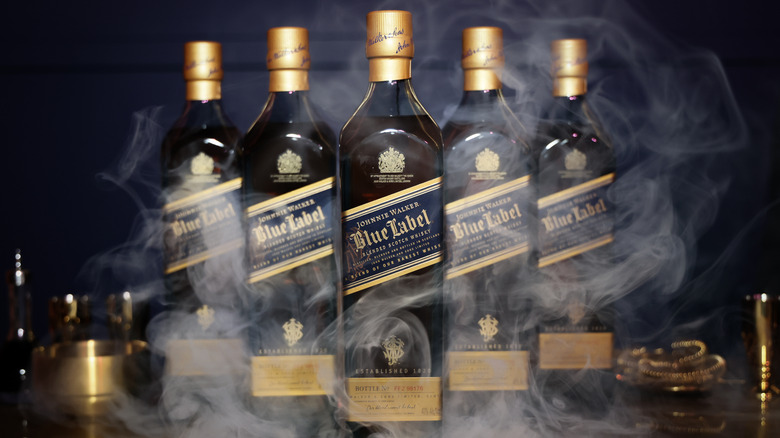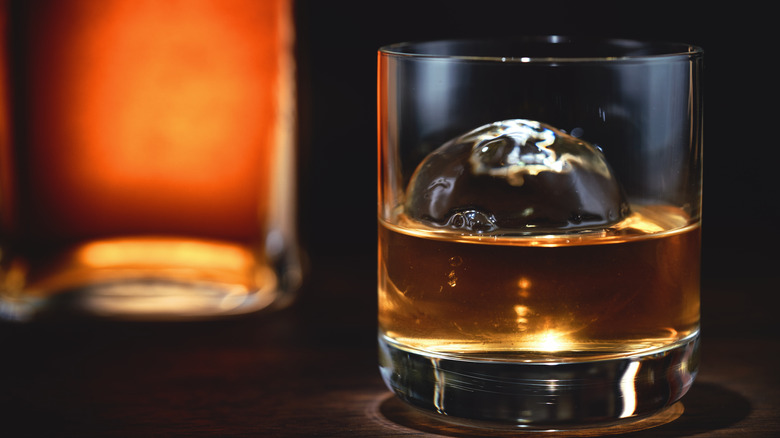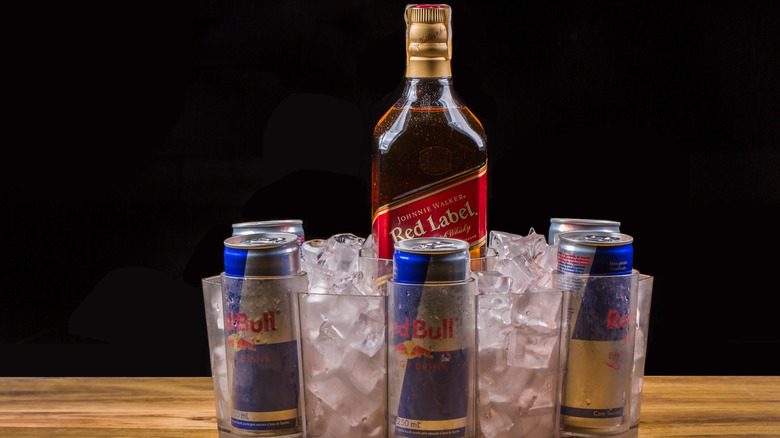The Reason Johnnie Walker Blue Is So Expensive
When certain brands of whisky (or whiskey) gain a reputation for being expensive, there are usually two major factors that explain why. One is that there is a limited supply of the drink, and the second is that the whisky is old. For super premium whiskies, we're talking old enough to vote in the U.S. — 18 years or more, for some labels. Both of these factors apply in the case of Johnnie Walker Blue Label.
Not only is Blue Label a notably high-quality, long-aged, blended scotch whisky, but it's also a very rare one. For every 10,000 casks of whisky aged by Johnnie Walker, only one (on average) displays the necessary flavor and character for it to acquire Blue Label status. This rarity helps to increase the value of the scotch, which often sells for $160 per bottle or more.
Of course, age matters, too. The extended barrel aging of Blue Label — its blend reportedly consists of whiskies aged 28 years or more — translates to wonderfully smooth and nuanced flavors, but also a very limited supply. The latter has to do with the "angel's share," the industry term for the amount of liquor lost due to evaporation as it sits in the barrel. When whisky is aged for decades, as much as half or more of the barrel contents can evaporate over time. What is already a rarity becomes that much rarer, a major boon to Blue Label's cult status.
Johnnie Walker Blue Label has always been expensive
When Johnnie Walker Blue Label was first released back in 1992, it was the most expensive whisky on the market, with a price (almost $150) close to the one it commands now. The only other liquor that came close to matching its price tag was XO Cognac. Today, Blue Label has lost its number-one status, thanks in part to a boom in bourbon consumption and hype around brands like Blanton's and Pappy Van Winkle. Bottles of these whiskeys on the secondary market can go for as much as $1,000.
Johnnie Walker's Blue label is still nothing to sneeze at, but the brand has introduced newer, more expensive ultra-luxury bottles in years past, such as King George V and The John Walker. These labels can also reach a value of $1,000 or more. Meanwhile, its Blue Label remains what it has been since its initial release: A rare and expensive scotch that isn't ludicrously-priced, but has a long reputation for quality.
Johnnie Walker Blue Label's master blenders have access to a stock of over 10 million casks at more than 80 different Scottish distilleries to blend this special whisky together. A tiny percentage of these casks prove worthy enough for use, and their ages are estimated to range from 28 to 60 years old. Jim Beveridge, a Johnnie Walker master blender, told the London Spirits Competition that Blue Label whisky reveals its sophisticated flavors in a "rolling wave," with signature tasting notes of sandalwood, cedar, sherry, and rose.
How does the Johnnie Walker Blue compare to the brand's other labels?
Most of Johnnie Walker's labels are differentiated based on color, ascending in price from red, black (and double black), to green, gold, platinum, and finally, blue. All save the final two are commonly sold for less than $100.
Johnnie Walker Red Label is currently shipped to more than 180 nations around the globe, and has maintained its status as the top-selling whisky in the world since 1945. Red Label has no aging requirements for its blend, beyond the minimum three years in the cask stipulated for all Johnnie Walker whiskies. Black Label whisky, however, uses only blends of 12 years old or greater, while those chosen for Green Label have aged 15 years or more, and its Platinum Label whiskies have a minimum of 18 years.
Gold Label Reserve bottles from Johnnie Walker no longer carry an age statement, but before 2012, they were made of whiskies aged 18 years and up. Nowadays, this label is noted for its honeyed character, and is priced somewhere between the Green and Platinum Labels. This, of course, leaves Blue Label at the top of the line. Look at the strict quality requirements for whiskies that are cheaper and less prized than the Blue Label, and you'll gain another understanding of why the pride of Johnnie Walker's so lauded and expensive.



